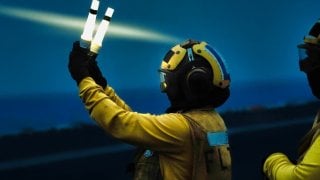The Houthis are Freaked: The U.S. Navy Has 2 Aircraft Carriers Watching and Waiting
Two U.S. Navy aircraft carriers, USS Abraham Lincoln (CVN-72) and USS Theodore Roosevelt (CVN-71), will remain in the Middle East to deter potential aggression from Iran and its proxies, such as Hezbollah and the Houthis.
Summary and Key Points: Two U.S. Navy aircraft carriers, USS Abraham Lincoln (CVN-72) and USS Theodore Roosevelt (CVN-71), will remain in the Middle East to deter potential aggression from Iran and its proxies, such as Hezbollah and the Houthis.
-This decision follows recent attacks by Hezbollah on Israel, heightening tensions in the region.
-The extension of these carriers' deployments underscores the U.S. commitment to regional stability and support for Israel, although it leaves the Navy stretched thin, particularly in the Indo-Pacific where U.S. carrier presence is currently limited.
Two U.S. Carriers To Remain in the Middle East to Deter Iran and its Proxies
Two of the three United States Navy's Nimitz-class nuclear-powered aircraft carriers based out of San Diego, California, will continue to remain in the Middle East, the sea service announced on Monday. USS Abraham Lincoln (CVN-72) was set to replace USS Theodore Roosevelt (CVN-71), but now both flattops will remain in the region to deter further aggression from Iran and its proxies like the Houthis .
The decision to keep the two carriers – and their respective strike groups – in the U.S. Central Command (CENTCOM) area of responsibility came after the Lebanese-based Hezbollah carried out strikes against Israel over the weekend. Although the attacks resulted in little damage, tensions remain high, and Washington is seeking to avoid escalation.
"Given the tensions in the Middle East and given our commitment to continue to support Israel’s defense and deter potential aggression, the secretary did order an extension of Theodore Roosevelt carrier strike group," said Air Force Maj. Gen. Pat Ryder, the top Pentagon spokesman.
Collectively the two carriers carry around 11,000 personnel.
Aircraft Carrier Rotations
The fourth Nimitz-class carrier departed San Diego in January and has entered its eighth month of service. Given that it takes a U.S. Navy carrier strike group (CSG) about three weeks to travel from the Middle East to Naval Base San Diego, means that CVN-71 won't be home until at least October – and that is only if the deployment isn't further extended.
The last carrier sent to the region, USS Dwight D. Eisenhower (CVN-69) saw her deployment extended three times, totaling nine months. The warship finally returned home in late June, and USS Theodore Roosevelt arrived in early July.
The U.S. Navy has maintained a near-constant rotation of carriers to the CENTCOM Area of Responsibility. That has included USS Harry S. Truman (CVN-75) which was deployed to the Mediterranean in February 2022 following Russia's unprovoked invasion of Ukraine; followed by USS George W. Bush (CVN-77), while USS Gerald R. Ford (CVN-78), the lead vessel of the U.S. Navy's newest class of nuclear-powered supercarriers, saw her deployment extended last fall in response to the Israel-Hamas War.
What About the Indo-Pacific?
The deployment of two of the three San Diego-based carriers to the Middle East has left the U.S. Navy stretched thin. The sea service continues to play a game of "musical chairs" with its aircraft carriers, and as reported this week there are currently no American flattops operating in the Indo-Pacific at this time.
However, the Italian Navy's flagship aircraft carrier ITS Cavour (CVH-550) and frigate ITS Alpino (F594) recently carried out joint exercises with the U.S. Navy destroyer USS Dewey (DDG-105) in the Philippine Sea.
In addition, USS George Washington (CVN-73) recently completed a "hull swap" with USS Ronald Reagan (CVN-76) and will soon head to her new homeport in Yokosuka, Japan. But until that time, the U.S. presence in the Indo-Pacific will remain limited.
Author Experience and Expertise: Peter Suciu
Peter Suciu is a Michigan-based writer. He has contributed to more than four dozen magazines, newspapers, and websites with over 3,200 published pieces over a twenty-year career in journalism. He regularly writes about military hardware, firearms history, cybersecurity, politics, and international affairs. Peter is also a Contributing Writer for Forbes and Clearance Jobs. You can follow him on Twitter: @PeterSuciu. You can email the author: [email protected].
Image Credit: Creative Commons.


